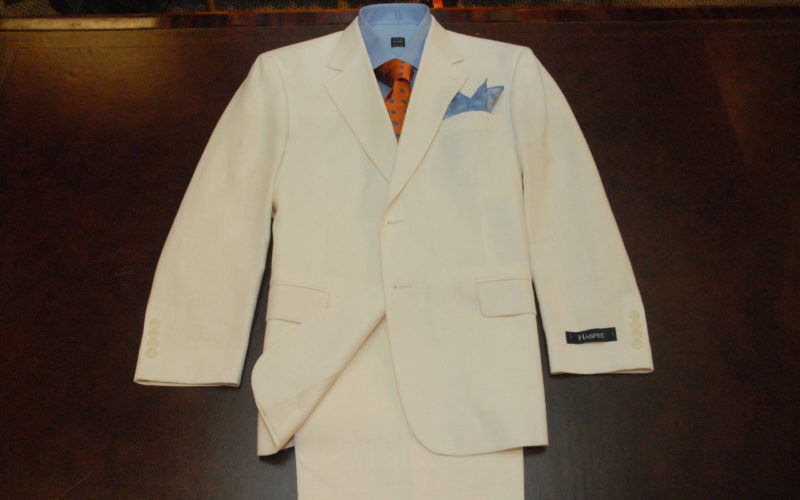Q. When is it correct to wear a white dinner jacket?
A. Well, this is definitely NOT the time of year to concern yourself with a white dinner jacket, because it is a warm-weather/summertime-only garment. And I hope you are not confusing it with “white tie.” Although they are each a form of men’s formal evening attire, they are two quite different types of dressing.
In the hierarchy of formal menswear, evening dress is divided into two general categories: the most formal is “white tie and tails”; one step down in formality is the less-dressy “black-tie” dressing (often referred to as a tuxedo or dinner jacket).
White tie and tails: This is a matched formal suit with an unusual single-breasted jacket, called a tailcoat, cut short in front with long tails in the back and worn with trousers that match the jacket. A white cotton pique waistcoat (formal vest) is an essential part of the combination. The shirt is white cotton with a stiffly-starched bosom and a wing collar; it is worn with a white cotton pique bowtie. Most men find very few times in their lives when this degree of formality is called for; as a result, it is seldom part of a man’s clothing collection.
Black-tie: On the other hand, this matched suit is a timeless investment. It is almost always black (sometimes midnight blue). The shirt is always white with vertical pleats in the front and with French cuffs. The bowtie is generally black, although some dapper men enjoy wearing a variation, such as a festive black-watch plaid bowtie during this holiday season. The lightweight wool suit is cut much like a business suit. A ribbon that matches the silk fabric of the jacket’s lapel runs down the outside of the trouser leg.
(In summer, a slightly less formal white dinner jacket may be substituted for the matching black jacket of the tuxedo; it is worn with black formal trousers. (All else remains the same.) Black-tie jackets are fashioned in one of three different collar and lapel styles: shawl, peaked, or notched. Lapels are either satin, a silk-like, smooth, glossy fabric or grosgrain (pronounced grow’-grain), a heavy, ribbed silk fabric. Grosgrain is also known as faille, (pronounced file).
Along with the three types of lapels, there are two types of closings: single-breasted and double-breasted. A double-breasted jacket is kept buttoned at all times, and is somewhat more dressy. Because it comes and goes in style, it’s best not to choose double-breasted as the style of a man’s first tuxedo.
Formal dress shirts are worn with cuff links and classic studs. These should be a simple design in gold, silver, or gold plate. They may have opaque stones such as onyx, mother-of-pearl, lapis lazuli, (but no clear, glittery gems, such as diamonds or emeralds).
Interestingly, although the totally correct shirt for black-tie attire has the standard straight-point turned-down collar, the wing collar shirt is so flattering that it has become quite widely accepted. And, in the most elegant traditional circles, wrist watches are left at home when a man is formally dressed.
No matter whether you remain strictly conventional or choose to insert one or two of the accepted variations, is up to you. As formal evening clothes are generally worn at social events with women attending, I’ll tell you something you may not know, but should. Like James Bond, every man looks wonderful – debonair, sexy, and in command – when he is in formal attire. Ask any woman.
Please send your men’s dress and grooming questions to MALE CALL: Lois.Fenton@prodigy.net









